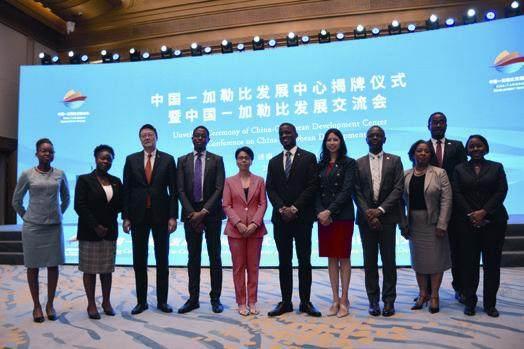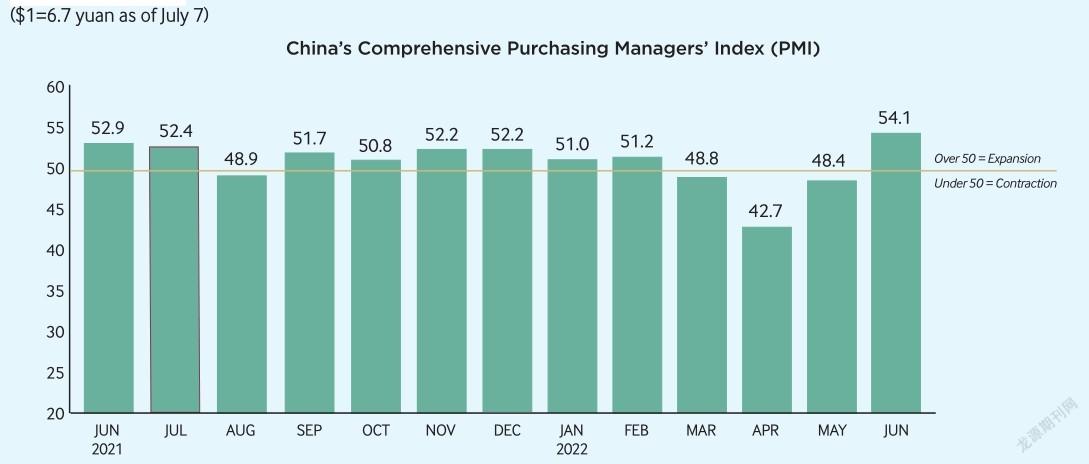THE CARIBBEAN CONNECTION
2022-07-18

Inauguration of the China-Caribbean Development Center in Jinan, capital of Shandong Province, on July 6. The center is expected to strengthen China’s cooperation with Caribbean countries.
The event also announced cooperation projects between China and Caribbean nations, including the center’s donation of anti-pandemic materials, collaboration with Guyana on fisheries training, and the launch of an international information exchange platform.
Children pick hot peppers to experience agrarian life in a village in Xiangtan City, Hunan Province, on July 4.

The fourth volume of Xi Jinping: The Governance of China has been published by Foreign Languages Press in both Chinese and English, Xinhua News Agency reported on July 2. The book will be available worldwide.
The latest volume contains a compilation of 109 pieces of spoken and written works of Xi Jinping, General Secretary of the Communist Party of China Central Committee, from February 3, 2020, to May 10 this year along with 45 photographs taken since January 2020. It is divided into 21 sections by topic.
Xi has led the Party and the people in efforts to respond to changes and open up new prospects, while making a penetrating analysis of major theoretical and practical issues concerning the development of the Party and the country, the publisher said.
Employing originality in vision and a wide range of ideas and strategies, Xi has provided answers to questions concerning the present and future of China and its people, as well as the wider world, according to the publisher.
This volume is designed to help officials and the public better understand and apply Xi Jinping Thought on Socialism with Chinese Characteristics for a New Era. It is also intended that this volume will keep the international community abreast of the latest developments in Xi’s thoughts, and explain the development path that China has chosen and its governance approach and theory, the publisher said.
A major part of China’s west-toeast power transmission program kicked off on July 1, a further boost to the nation’s coordination of development between regions.
With its transmission line stretching approximately 2,080 km, the Baihetan-Jiangsu 800-kV ultra-high-voltage (UHV) direct current power transmission project transmits clean hydropower from Baihetan, the world’s second largest hydropower station, in Sichuan Province, to Jiangsu Province.
It is the world’s first UHV direct current power transmission project using a new approach that combines the conventional direct current and flexible direct current technologies, according to the State Grid Corp. of China.
The project has a power transmission capacity of 8 million kW and has the capacity to deliver more than 30 billion kWh of clean electricity annually, helping reduce carbon dioxide emissions by over 25 million tons every year, the company said.
China’s water and soil erosion area continued to decrease in 2021, according to the Ministry of Water Resources.
The country’s water and soil erosion area stood at 2.67 million square km in 2021, down 18,500 square km, or 0.69 percent, compared with 2020, according to monitoring data on soil and water loss analyzed by the ministry.
Among the total, the area of hydraulic erosion is 1.11 million square km, down 1.27 percent year on year. The wind erosion area of 1.57 million square km is down 0.27 percent from a year earlier.
The ministry said that in the future it will work with other departments to strictly control water and soil loss caused by human activities, strengthen forest and grassland restoration efforts, and elevate the level of scientific governance to tackle water and soil erosion.
A new highway traversing the Taklimakan Desert in Xinjiang Uygur Autonomous Region was put into operation on June 30.
Located in south Xinjiang’s Bayingolin Mongolian Autonomous Prefecture, the highway, connecting Yuli and Qiemo counties, is the third to cross the Taklimakan Desert, the world’s second largest shiftingsand desert.
With the designed speed of 60 or 80 km per hour for different sections, the highway has a total length of 334 km, with 307 km passing through the desert.
Construction of the highway began in October 2017 and total investment on the project is estimated at 1.75 billion yuan ($261.5 million).
Children play at a water park in Nanchang, Jiangxi Province, on July 1.

China will grant its public widerranging and more convenient access to national historical archives, the country’s National Archives Administration said.
The administration has recently introduced a set of new guidelines regarding the disclosure of archives to the general public. The new guidelines made stipulations regarding the principles, circumstances and procedure of archive disclosure, as well as how the public can access and use the archives.
According to the guidelines, individuals and organizations with proper credentials can access disclosed archives on-site or via virtual channels including on websites and via e-mail, ensuring streamlined archive access.
In addition, as per China’s new Archives Law enacted in January 2021, foreign individuals and organizations now enjoy equal rights to access disclosed archives in China. The administration reiterated that the disclosure of archives will be carried out in accordance with China’s national security laws.
The guidelines will come into effect on August 1.
The average monthly temperature across China reached 21.3 degrees Celsius in June, the hottest June since 1961, China Meteorological Administration(CMA), the country’s top meteorological agency, said on July 5.
The June temperature was 0.9 degree Celsius higher than usual. Many regions including Henan and Shandong provinces registered the highest June temperature in history, according to the CMA.
Heat waves blanketed parts of China from June 13 to 26, affecting over 600 million people. A county in Hebei Province saw its temperature hit 44.2 degrees Celsius on June 25.
Fang Xiang, Deputy Director of China’s National Meteorological Center, attributed the high temperature to the strong warm high pressure system which controlled north China’s weather during that period.
In July, south China, parts of southwest China and east China might see lower average temperatures than previous years, while the rest of China might report similar or higher temperatures, according to Fang.
Visitors look at cotton automatically packed by a cotton picker during a regional agricultural machinery expo in Urumqi, Xinjiang Uygur Autonomous Region, on July 3.

Chinese people’s average life expectancy has increased to 77.93 years, Mao Qun’an, deputy head of the office responsible for the promotion of the Healthy China initiative, said at a press conference on July 5.
In 2016 when China rolled out the Healthy China 2030 blueprint, the figure was 76.5.
China leads middle and high-income countries in major health indicators, and the targets set for 2020 in the blueprint have largely been achieved, said Mao.
Mao said a policy system for health promotion has already taken shape, health risk factors have been brought under effective control, the capacity to provide health services has been substantially improved, and major diseases have been effectively controlled.
The Chinese A-share market raised 311.9 billion yuan ($46.5 billion) via initial public offerings(IPOs) in the first half of the year, up 46 percent from a year ago and topping the global chart for financing scale, according to data from financial information provider Wind.
In terms of funds raised, the Shanghai and Shenzhen stock exchanges ranked first and second respectively across the world during the period, accounting for nearly half of the global total, Wind data showed.
The boom in the A-share market stood in contrast with the global financial market, which has cooled off after hitting new highs in both the number of IPOs and financing scale last year.
The growth of the A-share market was mainly shored up by the Nasdaq-style sci-tech innovation board (known as the STAR market) on the Shanghai Stock Exchange and the tech-heavy ChiNext market on the Shenzhen Stock Exchange, as well as the return of red chip companies, or companies registered overseas but operate in the Chinese mainland, analysts said.
Enterprises in emerging sectors of strategic importance, including information technology and high-end equipment manufacturing, dominated the IPO list, as they made up over 90 percent of the firms floated on the two bourses during the period.
The proportion the digital economy contributes to China’s GDP rose from 21.6 percent in 2012 to 39.8 percent in 2021, with its scale increasing from 11 trillion yuan($1.65 trillion) to over 45 trillion yuan ($6.7 trillion) during that period, according to the Ministry of Industry and Information Technology.
The country has built the world’s largest and most technologically advanced network facilities. By the end of May, it had provided full fiberoptic network coverage to all of its prefecture-level cities and established 1.7 million 5G base stations.
China has also accelerated the integration of big data, cloud computing and artificial intelligence with such sectors as energy, healthcare, transportation, education and agriculture.
In 2021, the value-added output of major information technology manufacturers rose 15.7 percent year on year, hitting its highest level in a decade, while the revenues of software and information technology services as well as Internet and related services also registered doubledigit growth, the ministry said.
Trading of exchange-traded funds (ETFs) under the mainlandHong Kong stock connect programs began on July 4, marking a significant step toward deepening cooperation between capital markets of both sides.
The inclusion of ETFs in stock connect programs will facilitate investment for both domestic and overseas investors, and help Chinese mainland and Hong Kong asset managers and brokers further improve their management and service, Cai Jianchun, General Manager of the Shanghai Stock Exchange, said at the online launch.
Among the first batch of ETFs included in the stock connect programs, 83 are from the Chinese mainland’s A-share market and four are from the Hong Kong stock market.
As an investment product widely recognized by domestic and overseas investors, ETFs have the advantages of diversified investment, openness, low transaction cost and high efficiency, according to Sha Yan, General Manager of the Shenzhen Stock Exchange.
The inclusion of ETFs will enrich cross-border investment products, provide more investment convenience and opportunities for domestic and overseas investors, and promote the sustained, stable and healthy development of both the Chinese mainland and Hong Kong markets, she added.
Profitability of Chinese enterprises improved in the second quarter of the year, according to a survey conducted by the People’s Bank of China, the central bank.
The profitability index stood at 51.2 percent, up 2 percentage points from the previous quarter, staying above the 50-mark separating expansion from contraction, according to the survey.
Among the surveyed enterprises, some 31.6 percent said they earned more profit or pared their losses in the April-June period, while 39.3 percent said profits or losses of their firms remained unchanged from the previous quarter.
The business climate index dipped to 48.7 percent from 53.4 percent in the previous quarter. Over 60 percent of the surveyed entrepreneurs deemed conditions “moderate,” while about 17 percent said business operations were “good.”In this quarterly assessment, over 5,000 industrial enterprises were surveyed in all areas of the country except for Tibet Autonomous Region. The survey contained questions concerning the production, costeffectiveness and investment activities of enterprises.
Rail cargo volume, a key indicator of economic activity, rose 5.5 percent year on year in the first half of 2022, data from the China State Railway Group Co., Ltd.(China Railway) showed on July 2.
A total of 1.95 billion tons of cargo was transported, 102 million tons more than that in the same period last year, according to the company.
The number of China-Europe freight train trips rose 2 percent year on year to 7,473 in the six months. The trains carried 720,000 twenty-foot equivalent unit containers, up 2.6 percent from a year earlier.
In the first five months of the year, China received $47.68 billion in foreign capital for major foreign-funded projects, each with a contracted investment of at least $100 million, up 40.3 percent year on year, data from the Ministry of Commerce showed on June 30.
The sum accounted for 54.3 percent of paid-in foreign investment nationwide during the period, according to the data.
Shu Jueting, a spokesperson for the ministry, said at a press briefing that a bevy of global firms have sped up their business expansion in China, which shows an unchanged confidence in the Chinese market and their longterm business prospects in China.
The ministry will continue to ramp up support for major foreign-invested projects and help address difficulties faced by enterprises, she said.
China’s international trade in goods and services combined increased 14 percent year on year to 3.75 trillion yuan ($560.2 billion) in May, according to the State Administration of Foreign Exchange.
Exports of goods came in at 1.86 trillion yuan ($278.3 billion) in May, and imports at 1.46 trillion yuan ($218.3 billion), resulting in a surplus of 402.2 billion yuan ($60 billion).
Trade in services saw a deficit of 50.8 billion yuan ($7.6 billion), with the sector’s exports and imports standing at 188 billion yuan($28 billion) and 238.8 billion yuan ($35.6 billion), respectively.
In dollar terms, exports of goods and services trade reached $306.3 billion in May, while imports stood at $253.9 billion, resulting in a surplus of$52.4 billion.

